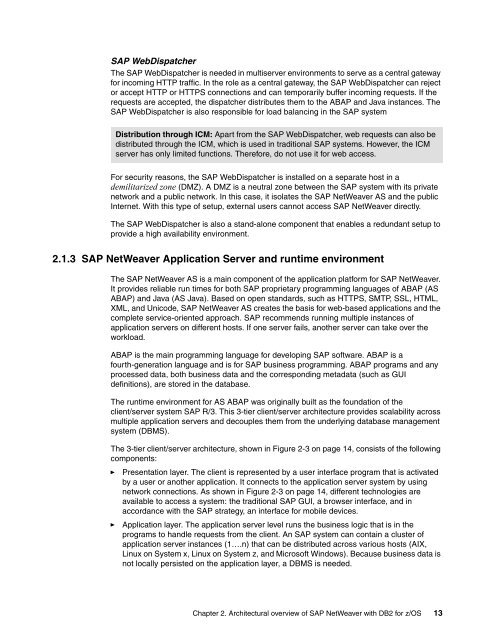Download PDF - IBM Redbooks
Download PDF - IBM Redbooks
Download PDF - IBM Redbooks
You also want an ePaper? Increase the reach of your titles
YUMPU automatically turns print PDFs into web optimized ePapers that Google loves.
SAP WebDispatcher<br />
The SAP WebDispatcher is needed in multiserver environments to serve as a central gateway<br />
for incoming HTTP traffic. In the role as a central gateway, the SAP WebDispatcher can reject<br />
or accept HTTP or HTTPS connections and can temporarily buffer incoming requests. If the<br />
requests are accepted, the dispatcher distributes them to the ABAP and Java instances. The<br />
SAP WebDispatcher is also responsible for load balancing in the SAP system<br />
Distribution through ICM: Apart from the SAP WebDispatcher, web requests can also be<br />
distributed through the ICM, which is used in traditional SAP systems. However, the ICM<br />
server has only limited functions. Therefore, do not use it for web access.<br />
For security reasons, the SAP WebDispatcher is installed on a separate host in a<br />
demilitarized zone (DMZ). A DMZ is a neutral zone between the SAP system with its private<br />
network and a public network. In this case, it isolates the SAP NetWeaver AS and the public<br />
Internet. With this type of setup, external users cannot access SAP NetWeaver directly.<br />
The SAP WebDispatcher is also a stand-alone component that enables a redundant setup to<br />
provide a high availability environment.<br />
2.1.3 SAP NetWeaver Application Server and runtime environment<br />
The SAP NetWeaver AS is a main component of the application platform for SAP NetWeaver.<br />
It provides reliable run times for both SAP proprietary programming languages of ABAP (AS<br />
ABAP) and Java (AS Java). Based on open standards, such as HTTPS, SMTP, SSL, HTML,<br />
XML, and Unicode, SAP NetWeaver AS creates the basis for web-based applications and the<br />
complete service-oriented approach. SAP recommends running multiple instances of<br />
application servers on different hosts. If one server fails, another server can take over the<br />
workload.<br />
ABAP is the main programming language for developing SAP software. ABAP is a<br />
fourth-generation language and is for SAP business programming. ABAP programs and any<br />
processed data, both business data and the corresponding metadata (such as GUI<br />
definitions), are stored in the database.<br />
The runtime environment for AS ABAP was originally built as the foundation of the<br />
client/server system SAP R/3. This 3-tier client/server architecture provides scalability across<br />
multiple application servers and decouples them from the underlying database management<br />
system (DBMS).<br />
The 3-tier client/server architecture, shown in Figure 2-3 on page 14, consists of the following<br />
components:<br />
► Presentation layer. The client is represented by a user interface program that is activated<br />
by a user or another application. It connects to the application server system by using<br />
network connections. As shown in Figure 2-3 on page 14, different technologies are<br />
available to access a system: the traditional SAP GUI, a browser interface, and in<br />
accordance with the SAP strategy, an interface for mobile devices.<br />
► Application layer. The application server level runs the business logic that is in the<br />
programs to handle requests from the client. An SAP system can contain a cluster of<br />
application server instances (1….n) that can be distributed across various hosts (AIX,<br />
Linux on System x, Linux on System z, and Microsoft Windows). Because business data is<br />
not locally persisted on the application layer, a DBMS is needed.<br />
Chapter 2. Architectural overview of SAP NetWeaver with DB2 for z/OS 13

















